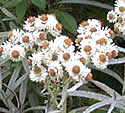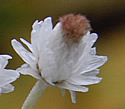Anaphalis margaritacea (Pearly Everlasting)
| Also known as: | Large-flowered Everlasting |
|---|---|
| Genus: | Anaphalis |
| Family: | Asteraceae (Aster) |
| Life cycle: | perennial |
| Origin: | native |
| Habitat: | part shade, sun; dry fields, roadsides, edges of woods |
| Bloom season: | July - October |
| Plant height: | 1 to 3 feet |
| Wetland Indicator Status: | GP: FACU MW: FACU NCNE: FACU |
| MN county distribution (click map to enlarge): |  |
| National distribution (click map to enlarge): |  |
Pick an image for a larger view. See the glossary for icon descriptions.
Detailed Information
Flower: 

![[photo of male flowers]](/udata/r9ndp23q/white/pearly-everlasting_0928_175128-t.jpg) Generally flat-topped clusters of numerous ¼ to 1/3-inch flower heads at the top of the plant. There are separate male and female flowers, usually on separate plants. Male flowers are globular with numerous slender, erect yellowish brown staminate flowers in the yellow center disc.
Generally flat-topped clusters of numerous ¼ to 1/3-inch flower heads at the top of the plant. There are separate male and female flowers, usually on separate plants. Male flowers are globular with numerous slender, erect yellowish brown staminate flowers in the yellow center disc.
![[photo of female flowers]](/udata/r9ndp23q/pd/anaphalis-margaritacea-7-t.jpg) Female flowers are globular to egg-shaped with a yellowish to dark brown bristly ring around the top of the flower head. Both genders have what appear to be numerous tiny white petals in many layers around the center. These are actually bracts. The bracts on the female flowers do not spread out much until seed starts forming.
Female flowers are globular to egg-shaped with a yellowish to dark brown bristly ring around the top of the flower head. Both genders have what appear to be numerous tiny white petals in many layers around the center. These are actually bracts. The bracts on the female flowers do not spread out much until seed starts forming.
Leaves: 

![[photo of leaves]](/udata/r9ndp23q/white/pearly-everlasting_0731_112222-t.jpg) Leaves are 3 to 5 inches long, to ¾ inch wide, toothless, often with wavy or rolled edges, covered in white woolly hairs on both surfaces but especially on the underside, sharply pointed at the tip with no leaf stalk. Stems are densely covered in woolly white hairs.
Leaves are 3 to 5 inches long, to ¾ inch wide, toothless, often with wavy or rolled edges, covered in white woolly hairs on both surfaces but especially on the underside, sharply pointed at the tip with no leaf stalk. Stems are densely covered in woolly white hairs.
Fruit: 
![[photo of fruit]](/udata/r9ndp23q/white/pearly-everlasting_0928_175223-t.jpg) Fruit is a small brown seed with a tuft of white hairs to carry it off in the wind.
Fruit is a small brown seed with a tuft of white hairs to carry it off in the wind.
Notes:
Pearly Everlasting is common along roadsides in the northeast part of the state. Look for it in late summer. Similar species is Sweet Everlasting (Pseudognaphalium obtusifolium), which does not have separate male and female flowers. As the common name Everlasting suggests, the flower heads retain their shape well and are commonly used in dried flower arrangements.Native Plant Nurseries, Restoration and Landscaping Services ↓
More photos
Photos by K. Chayka taken at Wild River State Park, Chisago County and along roadsides on the North Shore in St. Louis and Lake counties.
Comments
Have you seen this plant in Minnesota, or have any other comments about it?
on: 2011-01-23 11:49:14
I planted this about two years ago in my parents field, the soil type is very sandy-loam. I planted them in full sun although there are some pesky cedars nearby that I'm trying to convince my Dad to get rid of. They have done wonderful! I had none of the transplants die and the following summer they had begun spreading outwards and flowering even more than the previous year. I would recommend this plant for someone who is looking to plant native species it is pretty and easy to grow and the deer don't seem to eat them.
on: 2014-08-29 17:55:42
I found Pearly Everlasting growing in the ditch on County road 155 just a short walk from my cabin. This flower is not on the distribution map as being present in Mille Lacs County. Perhaps I should collect a specimen for this one as well.
on: 2016-08-23 19:35:16
Found about 4 plants in the same area in the S part of Uncas Dunes along the trail. One of the reasons why I know the difference between Sweet and Pearly is this website when I researched these plants here :) Maybe they are transplants somehow since it's along a trail but I was flabbergasted by this. The map shows it as native and not rare though...
on: 2019-06-11 12:09:45
Yes, I believe we have Pearly Everlasting on a bank It is (June) here, so plants immature, apprx 4'x10', and 8'x12' We also have 2 Purple Lady Slipper plants, and possible swamp buttercup!
on: 2020-08-15 09:20:34
Several groups of Anaphalis margaritacea growing in yard, in perimeter of drive and on semi-wild banks with W, SW and S exposures. Native "soil" is mostly clay, although Anaphalis seems to grow in areas where leaf litter accumulates over winter. Will try to harvest seeds this fall and continue spread of Anaphalis and Antennaria plantaginifolia (Pussytoes) in similar areas of property.
on: 2020-09-01 20:57:48
Found clusters of this growing at Fritz Loven Park.
on: 2022-09-15 18:03:19
I saw this growing near the Isabella River on the portage to Quadga Lake on 9/9/22. Was wondering what it was, so thanks to your site for identifying it!







 Pearly Everlasting plants
Pearly Everlasting plants more plants
more plants  more female flowers
more female flowers